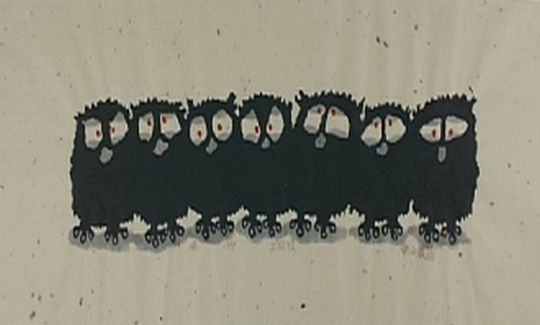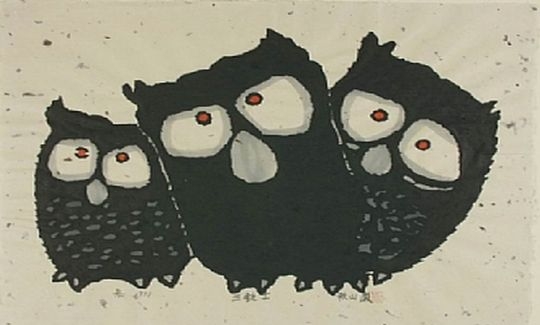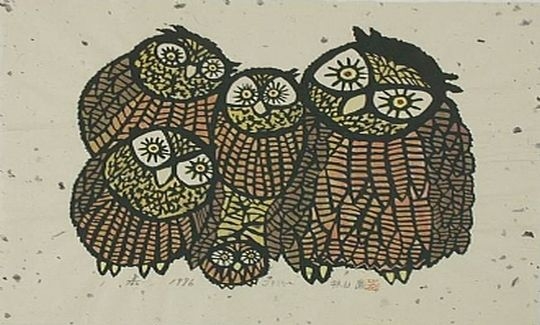An owl, a crow, a monk wandering in endless wastes of snow, all represented with gentle humour in these monochromatic black woodblock prints, each with two small red marks, on rough paper - these are indications that the work can only be that of the artist Akiyama Iwao. He was born in 1921 in the Oita Prefecture, and began his artistic career by painting in oils. He then turned to engraving, and ultimately to woodblock printing. From 1959 to 1966 Iwao studied with the famous Japanese print artist Munakata Shiko
(1903-1975).
Akiyama Iwao's woodblock prints convey a sense of roughness, of being unfinished. He uses Japanese paper in which there are tiny shavings of bark - indications that the paper is handmade and incorporates the original fibres. Making a calculated departure from elegance, from any attempt to beautify or refine the forms of his subjects, Akiyama presents them as black blots, without details and with no defined outline. All this gives his work an effect of folk-art, naive and direct.
Aside from his owls, crows, and wandering monks, haiku verses by the poet Issa (1763-1827), those of the Zen monk Taneda Santoka (1882-1940) - whom Akiyama had met - as well as his own poems, are also integrated in the prints. It was Taneda Santoka, so sensitive to nature and to man's presence in it, who has had the greatest influence on Akiyama's work. Santoka was an eccentric poet, wandering about Japan with his umbrella and begging-bowl like a Buddhist monk.
The combination of painting and calligraphy is not foreign to Japanese culture, and this is particularly apparent in the ink drawings, one of the classic arts learned by every educated person. As in the Zen paintings which incorporate haiku and other short poems, Akiyama tries to convey the essence of his work concisely and creatively, spontaneously and directly.
Creatures thus take pride of place in Akiyama's works, especially the owl and the crow, which reappear in version after version of his prints. In China and Japan the owl is a symbol of treachery. In Japanese folk-tales he is described as devouring his parents. Conversely, the crow is thought to be the messenger of the gods, a symbol of good fortune and an emblem of respect for parents - an important tenet in Japanese tradition. There is a Japanese aphorism which says that "the children of the crow find food for their parents". In Akiyama's prints, the owl is not at all sinister, but innocent, playful and poetic, and his relation to the crow is full of humour, in absolute contradiction to his "reputation" in folklore.
The owl is a bird of night, dormant by day. In two of Akiyama's prints he watches, with half-closed eyes, as a crow pecks at the eaves of a house in the middle of a hot day. From the owl's point of view, the crow's behaviour (or that of any other creature at midday) is evidence of stupidity. The poem by Issa inscribed on the work - "A hot day/he pecks at the eaves/ Silly crow" - helps us to understand this. Crows often show a tendency to imitate other creatures. Perhaps, in this instance, he is imitating a woodpecker searching for food beneath the bark of a tree. Obviously, imitating the action will not produce the desired results, so that Issa sees him as a simpleton - and so does the owl!
In another print the owl has "drunk the bitter drop" surrounded by new leaves which have fallen off the trees. Obviously, fresh leaves don't fall off trees, because they have only just sprouted. It is simply an illusion, caused by the owl's drunkenness or our assumptions. We know the owl is drunk because of the title - "Slightly drunk" - and Taneda Santoka's poem (Slightly drunk/ young leaves/fall) at the top of the print. But one has only to look at the owl's rolling eyes to realize what a shameful state he is in. Even though titles and inscriptions help us to understand, it is certainly possible to identify the owl as professor, prophet, musketeer, deity, or sage in Akiyama's prints unaided, because each owl has its own personality and character.
The composition of the prints with the little figure of the monk wandering amid vast, snowy landscapes is influenced by the Chinese ink drawings in which, as in the Laws of Confucius, everything has its place in the universe. Man may be tiny as compared to the force of nature, but this does not mean that he is of no importance in the cosmos. However, it is certainly apparent that man's subjection of nature is far removed from this tradition. The monk is Taneda Santoka himself, travelling throughout Japan in search of enlightenment. The first station on this road is the understanding that life and death are one and the same. Santoka's poem - Between life and death/snow falls/unceasingly - which appears in one of the prints, is an expression of this awareness.
Akiyama Iwao's works have been exhibited in Japan and in many other countries. The prints in this exhibition have been loaned to us by courtesy of Mr. Yuji Abe, Director of the Yoseido Gallery, Tokyo.



